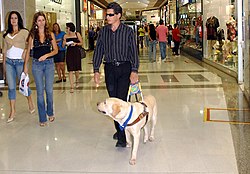


A working dog is a dog used to perform practical tasks, as opposed to pet or companion dogs.
Contents
Definitions vary on what a working dog is, they are sometimes described as any dog trained for and employed in meaningful work; other times as any dog whose breed heritage or physical characteristics lend itself to working irrespective of an individual animal's training or employment; and other times again it is used as a synonym for herding dog. [1] [2] [3]


